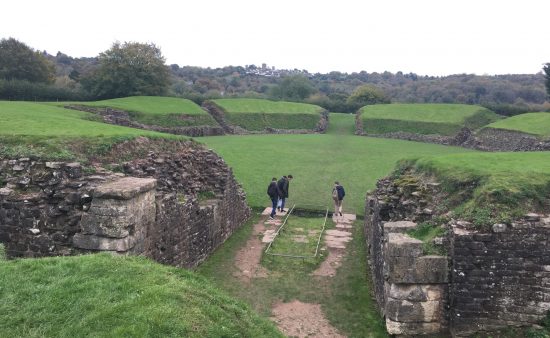A trip to Caerleon with the School of History
7 June 2022
Whilst studying BA Ancient History at Cardiff University, I was lucky enough to be part of a cohort that spent a day on a field trip to the ancient Roman fortress at Caerleon. The expedition’s purpose was to train us undergraduates in practical field observation for an archaeological analysis of ruins, rather than the analysis of literature and artwork that has already been preserved, translated and studied, something that we were far more familiar with and practiced at as students of Ancient History rather than Archaeology. Departing Cardiff at around 10 in the morning, the whole trip took around 8 hours, spending approximately 4 on the site of the fortress, a couple within the site-based museum, and with the site only being around 45 minutes by coach, thankfully not too much time spent travelling as the seats were really quite narrow due to the coach being repurposed from what I can only assume was a school mini-bus.
Initially constructed in approximately 75 AD, the fortress at Caerleon, known to the Romans as Isca, was founded to act as both a bastion against the volatile and initially hostile tribe of the Silures, and to guard the route into Wales to places such as Cardiff, from England. Housing the 2nd Legion Augusta for over two centuries, the fortress was a vast and indomitable structure, far more defensible and luxurious than a typical legionary marching camp, as it was built to be a permanent structure rather than simply an overnight base. We have come to know more about the site thanks to excavations that initially began in the 1920s.
We can dig up and preserve such stone foundations as can still be seen at Caerleon, however the skills that we were being trained in that day were in observing and analysing such ruins to allow us to make educated intuitions about the archaeology on display. We had covered many similar sites in lectures and seminars, being taught not only what to look for and what it meant, but also how to approach critical observation in general, understanding that everything had a purpose, and how we can best work out what those purposes were, based on the remains. This gave us an amazing opportunity to practice these skills in a practical scenario. It is interesting how often there are clear parallels between ancient and modern objects and layouts for things such as the fortresses’ barracks, and it was seemingly more important to have an open mind about your observations than it was to know huge amounts about the Romans prior.

The trip acts as a good demonstration of the kind of field trips that at least the School of History, Archaeology and Religion can take you on whilst studying at Cardiff University. The combination of an enhancement of your theoretical studies by taking you to practical sites, alongside being a generally fun day out all round, meant that field trips such as this one are much looked forward to by students. Being tour guided by world leading experts in their fields, we were given an exclusive insight into life at the fortress and nearby amphitheatre by our lecturers, that even paying visitors to the site would not normally receive.